Costumes & Characters
Criss Angel BELIEVE is a journey into the improbable, a voyage into the unconscious
of an ingenious master of illusion who moves back and forth between the real world
and a surreal, dreamlike parallel universe that is the product of his own twisted
imagination, Criss Angel plays the part of a mysterious dark prince endowed with
magical powers. In his waking dream, he sees extraordinary characters and creatures
such as the dazzling Kayala, the fiendish Crimson, four frayed ushers - the guardians
of an old imaginary baroque theater - and a chorus of characters appearing as rabbits,
cockroaches, and crows. Imagine a fantasy, an allegory, a highly theatrical tableau
of mood, reverie and emotion set against a backdrop of dreamlike darkness and light.
The complex, multidimensional costumes of Criss Angel Believe contribute to much
more than the show's look; some are not quite what they appear, as their design
or materials turn them into veritable magic props.
"Fabric is between the flesh and the soul. This is where I love to
slide."
— Mérédith Caron, Costume Designer
The show explores the theme of desire and seduction, this is reflected in the choice
of intense colors and attention to detail in costume making and design. Mérédith Caron’s
designs had to be complex and multidimensional because so many of the costumes contribute
more to the show than simply a look. Without giving away any of the illusionist’s
secrets, many aspects of the costumes include features and choices of materials that put
them into a category that is somewhere between costumes and props. Individual garments,
rags and bits of fabric may be integral to the illusionist’s performance, whether Criss
Angel is wearing them or another performer is contributing to the astonishing happenings
on stage.
The overall look of the show is rich and imbued with a patina of
Victorian atmosphere overlaid with a dream-like surrealism that the
show’s director Serge Denoncourt has dubbed “Weirdtorian.” The
costumes play a major role in creating the look, and are designed to
mesh with the set designs, the masks and puppets, the lighting and so
on. This is achieved through fabric choice, colors and cut. To this end,
leather, garnished gold, and jewels are used to full effect, while pleated and
stiffened fabrics undulate like waves. Other materials include linen, whose fibers
preserve the memory of the wearer's shape and gestures, as well as cotton netting,
crushed velvet, jute and help. For the dancers, stretchable tweed is used for
freedom of movement, while crinyl creates volume.
The cut of the coats – especially the men’s coats – is long and
sweeping with deep vents that are reminiscent of Victorian topcoats,
but Mérédith Caron is at pains to state that she has no interest in
recreating precise replicas of 19th century costumes. These are
interpretations that use the Victorian era as a jumping-off point for
entirely modern designs.
Mérédith points out that the “Weirdtorian” costumes contain references
to the worlds of Charles Dickens and Tim Burton, and therefore convey
a sense of darkness in all senses of the word – and the best fabric
for that is velvet. However the velvets she has used are by no means
off-the-shelf fabrics. Some are printed, others have three-dimensional
Paisley-like designs that reflect two surfaces very differently
depending on how the light strikes them. “There are a lot of black
fabrics in the costumes and that is unprecedented for Cirque,” says
Mérédith. “But they are a living black.”
Desire and seduction are integral to the show’s themes and many of the
more striking costumes evoke this through intense colors and richness
of detail. When Mérédith first met Criss Angel
she studied the contents of his own wardrobe and decided – as a first
step – to build on that by magnifying certain aspects of his existing
personal look and blending them with the visual direction of the show.
When he saw the finished costumes for the first time, Criss Angel had
a special request. He asked for the three letters “JDS” to be
embroidered in the collar of his coats. They are far too small and
subtle to ever be seen by the audience, but they mean a great deal to
Criss because they are his beloved late father’s initials.
"Everything on the stage is charged with magic. So given that we are
doing a magic show, we knew that everything, starting with the classic
magic show elements: the hat, the chair, the stool, and so on, would
be under constant scrutiny." — Michael Curry, Props and Puppets Designer
The lines between puppets, masks, props, costumes and scenery are not
always clearly defined. A mask may blend with a makeup design or a
costume. A puppet may be more like a costume than a marionette or it
could be big enough to be on the scale of the scenery. For example: an
electronic tornado is unleashed at one point in the show that is considered
part prop, part puppet, part set design – and all illusion.
| |
The rabbit that delivers the pre-show announcements is equipped with 11 servos:
He is completely robotic and is linked to the theatre’s sound system. There are
five other robotic and computer-controlled puppets. One is a huge robotic flower
that delivers the aerialist playing the part of Kayala.
|
There are many puppets in the show, including costume hybrid devices
worn by the performers, playing characters that have just come out of
the coma into which Criss Angel has been plunged.
Many of the puppet characters are animals, and many of them are
rabbits – and they come in all shapes, sizes and personalities. Some
are cute and adorable, others more threatening and evil. There are also rats,
moles, birds and sinister giants that are built from human bodies – a hybrid of
the performer’s body and the creature. “This gallery
of phantasmagorical characters puts forward odd, quirky and avant-
garde concepts that we would probably expect to see in a contemporary
opera or a fantasy film festival,” says Michael Curry.
There are many masks in the show. Masks have the ability to sharpen the characters
and keep them present. While they primarily help to establish character, some of
them may be involved in the illusions: During one scene there are 15 versions of
Kayala, all created using the masked face. Lightweight materials make it possible for
the dancers to perform wearing masks that extend two feet in front of them.
Kinetics are a major feature of the set design and the props, which are integral to
the illusions, blend not only with the set design but the lighting and projections too.
The Birth Machine and the War Machine are two of the major contraptions: they are not
static objects, they move, they spin, they roll, they catch fire, they transform, so
they are regarded as somewhere between props and puppets. The chainsaw that cuts Criss
in half has a real blade and has smoke billowing out of it. It is operated by a flying
performer. "The sheer precision of the trick props have been a wonderful challenge."



Crimson
As a monster of nightmarish proportions, Crimson is the antagonist
of the show. You'll find her often dressed in reds and blacks to symbolize
her evil nature. She fights desperately for Criss' love, and when she
doesn't get it... to destroy his life. Hidden behind her zippered mask,
Crimson is wearing a costume made of both genuine and fake leather -
particularly for the gaiters and leggings - and "Mirror of Holland" linen.
The skin effect was created by two layers of flesh-colored linen covered
by black netting that has been slashed and sewn back together, as though
the body had been scarred. Whether born from a world of excess or someone's
subconscious imagination, this disturbing character draws on northern
European influences.
Kayala
A foil to Crimson, Kayala is Criss' reciprocating love. She's a
wondrous beauty draped in white; born out of a large poppy, she acts as
the force of good. With its praying mantis-like bodice and its black
crinyl and organza train, the dress worn by the spectacular Kayala is
dripping with 18th century decadence. The dress is embroidered with
strips of gold and silver braid, with the whole pattern being
reconstituted and remade with a three-strand braid.
The Dolls
Inspired by models from the early Victorian period, the Dolls (Gigi,
Taz and Charissa) are damaged and their porcelain heads are cracked. The
Dutch tulip designs printed on the back velvet are based on 17th Century
paintings and enlarged paisley patterns.
The Ushers
Maestro, Luigi, Slim and Lars assistants to Criss,
bumbling about and acting as his link between the real world
and the world of Believe.
Lucky
Lucky is a white rabbit who turns up from time to time...
Other Characters
Hyena (a rabbit gone rabid), The Paparazzi (with cameras ablaze),
The Crowmen (black birds to prey on the weak), Grand Master
Tronik (a grand and beastly puppet), Mole (a creature of the
underworld), Zangelica (half girl, half rabbit, all legs),
Dega (a young rabbiteer), Auntie B & Father Luminus.
|
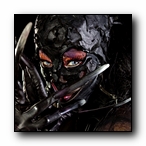

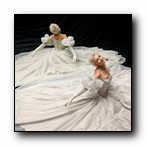
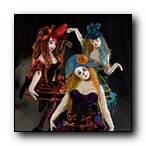
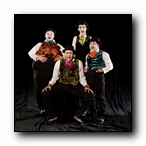
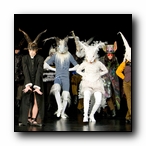
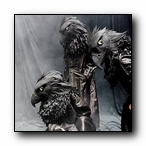
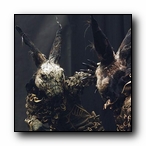
|
|

![]()




